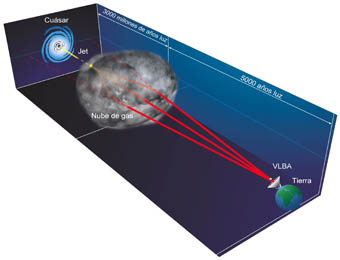
An international team of astromers in which participates the University of Valencia has discovered how the image of a distant quasar appears suddenly multiplied by refraction that produces a cloud of gas in our galaxy, the Milky Way. This phenomenon was predicted in the seventies, but it has been observed for the first time thanks to the North American network of radio interferometry (VLBA). The results of this study were recently published in the European journal 'Astronomy & Astrophysics'.
Scientists have observed the quasar 2023 +335, to 3,000 million light years from Earth, in a project that explores the evolution of three hundred quasars. By studying in detail the images of 2023 +335, astronomers noticed amazing changes in time intervals of weeks. These changes are due to the quasar light changes direction when passing through a gas cloud moving within our galaxy. "Like we would see to widen and multiply a point of light behind the ground glass of a bathroom window, we find that the image of our quasar 'dances' and multiplies when passes that cloud ahead," says Eduardo Ros, of the Max Planck Institute for Radio Astronomy (MPIfR, Bonn, Germany), former director of the Astronomical Observatory and professor on leave from the Department of Astronomy and Astrophysics at the University of Valencia, a member of the team that made the discovery. "This phenomenon is similar to the mirages in the desert or the sundogs that produce ice clouds with the sun's image," continues Ros.
This kind of mirage allows to study the properties of turbulent gas that fills much of the Milky Way. Astronomers have included the quasar 2023 +335 in the list of observations of the MOJAVE project in 2008, which is determining the behavior of matter surrounding the supermassive black hole in the nucleus of active galaxies or quasars. These black holes are the engine of a powerful jets of emission or 'jets' that expel matter in galaxies at speeds approaching that of light. The quasar 2023 +335 initially showed the typical structure of a quasar with a bright nucleus and 'jet'. However, in 2009 this object seemed to 'swell' and become a dotted line in bright sunlight. "We have never seen such a phenomenon before, among the hundreds of quasars and the thousands of images we are looking at," says Alexander Pushkarev, Crimean Astrophysical Observatory (Ukraine) and the MPIfR, the leader of the team that analyzed these observations.
The astronomers came up with the track of the multiple images when appreciating variations in the brightness of the quasar on observations made by other telescopes. These variations could only be caused by the dispersion of the light waves. Calculations indicate that the radio waves were dispersed by turbulent gas cloud located 5,000 light years from Earth (the diameter of the Milky Way is about 100,000 light years), in the direction of the constellation Cygnus. The size of the gas cloud, of this lump of galactic matter, is comparable to the distance between the Sun and Mercury, and the cloud moves through interstellar space at a speed of about 56 kilometers per second (200,000 km / h, slightly lower than the speed of Helios 2 the fastest spacecraft ever built).
"Monitoring of 2023 +335 in the coming years could provide new detections of this phenomenon, if other gas clouds in the Cygnus region are crossing the line of sight," says Matt Lister, Purdue University (USA .) MOJAVE project coordinator.
More information:
Last update: 4 de september de 2013 08:29.
News release



















